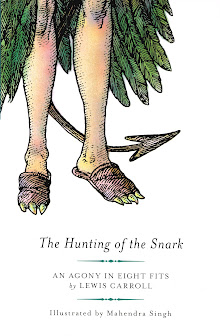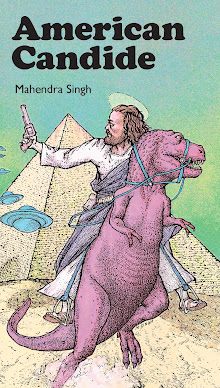
I'm very pleased to announce that Melville House is publishing my comixed version of Lewis Carroll's The Hunting of the Snark in the Fall of 2010. Alas, it will have to appear without the Commentaries which I've been working up so assiduously over the years but no matter, that will be remedied when the book goes into multiple printings after its appearance on Youtube in a blurry surveillance camera video of some American TV celebrity shoplifting it in a opiated stupor.
Melville House is run by the same discerning folks who put out the excellent blog, MobyLives, all of which is meant as an homage to Herman Melville, a man who knew a thing or two about long, fruitless quests for annihilating animals. Melville chose to clothe his Boojum in the blubbery lineaments of the fat, white whale, Moby Dick, (not the excellent kebab joint in Georgetown) and he also made certain that the whale's pursuers got a snootful of insane, nonsensical, contradictory ravings from their leader, Cap'n Ahab. In these critical matters, it's quite obvious that Melville was plundering Carroll's Snark in a classic example of what literary scholars call Anachronistic Plagiarism.
None the less, I'm in a forgiving mood today, as you might imagine and so we'll put aside these petty insinuations concerning the Second Greatest American Novel and move on to the far more pressing matter of Snarkian Ontology, exemplified here in the unassuming person of the Boots, seen above. Carroll makes little mention of this rather pedestrian character except for some perfunctory business with a spade in Fit the Fourth, and some commentators have even insinuated that the Boots did not really exist or that he might have been the actual murderer of the Baker, sharing as he does a "Boo" with the dreaded Boojum.
To all that I say phooey. However, drawing phooey is a bit trickier and it was only after considerable research by my crack team of crack-head researchers that we came up with a solution to all of the above: the Boots was Charles Darwin!

Carroll was probably present at the infamous 1860 debate on Darwinism between T.H. Huxley and Soapy Sam Wilberforce; we know that he owned and read Darwin's works; we even know that he and Darwin corresponded but we are uncertain as to the Great One's exact opinion on Natural Selection.
Well-oiled Carrollians suspect that he disapproved of this logical undoing of the basic tenets of all revealed religions on mainly philosophical grounds. Carroll's faith was unshakeable and more importantly, the Master of Nonsense certainly would have understood the difference between Faith and Logic as far as religions go, a simple mental operation which still seems beyond the limited cognitive abilities of many noisy commentators upon the subject today (so much for evolution, eh?). What might have perturbed Carroll could have been the spectacle of publicly quarreling over such private things, and hence, our choice of Darwin as the Boots.
Both Darwin and the Boots lurk in the shadows of Victorian England and the Snark alike. The former utterly and categorically demolished the entire logical basis of all organized religions almost apologetically, the latter utterly and categorically demolished the entire logical basis of Carroll's Snark almost apologetically. Both belief systems of religion and Snark are solely premised upon revelations, the verbal revelations of a god or a poet who presents us with a priori facts about the fictional Multiverses they have created. Carroll's colorless, practically blank persona of the Boots is a dead giveaway that there really is nothing going on here, that the Snark is just a sound and fury signifying nothing.
Nature and poetry alike shun vacuums, they make such an ontological mess of things and clever, up-to-date gods and poets alike eschew 'em. There's nothing worse than Nothing in the midst of your Something, it's a dead giveaway that you really are up to something and that's the very last thing you want your acolytes and readers to suspect. Fictional suspension of disbelief and all that, don't you know.
In short, there's something going on here, as usual. I'll leave it to the Carroll boffins to sort out the sticky details of all of the above revelations, for now, just take my word for it.












